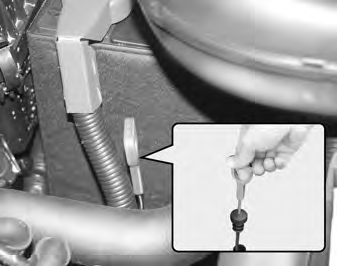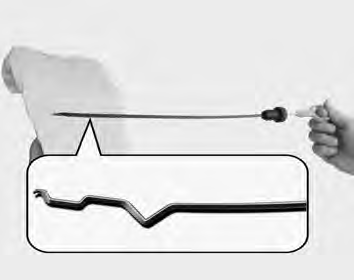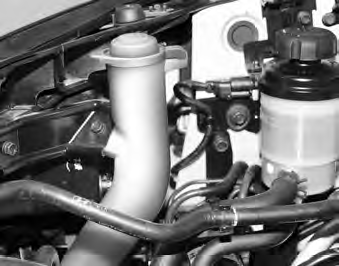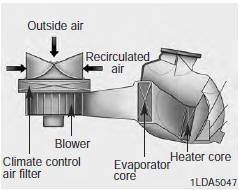Kia Sportage: Automatic transaxle

Checking the automatic transaxle fluid level The automatic transaxle fluid level should be checked regularly. Keep the vehicle on the level ground with the parking brake applied and check the fluid level according to the following procedure. 1. Place the selector lever in N (Neutral) position and confirm the engine is running at normal idle speed. 2. After the transaxle is warmed up sufficiently (fluid temperature 70~80 °C (158~176 °F)), for example by 10 minutes usual driving, shift the selector lever through all positions then place the selector lever in N (Neutral) or P (Park) position.

3. Confirm that the fluid level is in “HOT” range on the level gauge. If the fluid level is lower, add the specified fluid from the fill hole. If the fluid level is higher, drain the fluid from the drain hole. 4. If the fluid level is checked in cold condition (fluid temperature 20~ 30 °C (68~86 °F) add the fluid to “COLD” line and then recheck the fluid level according to the above step 2.
WARNING - Transaxle fluid The transaxle fluid level should be checked when the engine is at normal operating temperature. This means that the engine, radiator, radiator hose and exhaust system etc., are very hot. Exercise great care not to burn yourself during this procedure.
CAUTION • Low fluid level causes transaxle slippage. Overfilling can cause foaming, loss of fluid and transaxle malfunction. • The use of a non-specified fluid could result in transaxle malfunction and failure.
WARNING - Parking brake To avoid sudden movement of the vehicle, apply parking brake and depress the brake pedal before moving the shift lever.
NOTICE “COLD” scale is for reference only and should NOT be used to determine transaxle fluid level.
NOTICE New automatic transaxle fluid should be red. The red dye is added so the assembly plant can identify it as automatic transaxle fluid and distinguish it from engine oil or antifreeze. The red dye, which is not an indicator of fluid quality, is not permanent. As the vehicle is driven, the automatic transaxle fluid will begin to look darker. The color may eventually appear light brown. Therefore, have an Authorized Kia dealer change the automatic transaxle fluid according to the Scheduled Maintenance at the beginning of this section.
Changing the automatic transaxle fluid Have automatic transaxle fluid changed by an Authorized Kia Dealer according to the Maintenance Schedule at the beginning of this section.
Rear differential (4WD)
Checking or changing rear differential fluid Have rear differential fluid checked or changed by an Authorized Kia Dealer according to the Maintenance Schedule at the beginning of this section. Use only the specified rear differential fluid. (Refer to "Recommended lubricants and capacities" in section 8.)
Transfer case (4WD)
Checking or changing transfer case fluid Have transfer case fluid checked or changed by an Authorized Kia Dealer according to the Maintenance Schedule at the beginning of this section. Use only the specified transfer case fluid. (Refer to "Recommended lubricants and capacities" in section 8.)
Lubricants and fluids

Checking the washer fluid level The reservoir is translucent so that you can check the level with a quick visual inspection. Check the fluid level in the washer fluid reservoir and add fluid if necessary. Plain water may be used if washer fluid is not available. However, use washer solvent with antifreeze characteristics in cold climates to prevent freezing.
WARNING - Coolant • Do not use radiator coolant or antifreeze in the washer fluid reservoir. • Radiator coolant can severely obscure visibility when sprayed on the windshield and may cause loss of vehicle control or damage to paint and body trim. • Windshield Washer fluid agents contain some amounts of alcohol and can be flammable under certain circumstances. Do not allow sparks or flame to contact the washer fluid or the washer fluid reservoir. Damage to the vehicle or it's occupants could occur. • Windshield washer fluid is poisonous to humans and animals. Do not drink and avoid contacting windshield washer fluid. Serious injury or death could occur.
Body lubrication All moving points of the body, such as door hinges, hood hinges, and locks, should be lubricated each time the engine oil is changed. Use a nonfreezing lubricant on locks during cold weather. Make sure the engine hood secondary latch keeps the hood from opening when the primary latch is released.
Air cleaner

Element replacement Have the air cleaner element checked and replaced in accordance with the maintenance schedule.
NOTICE Do not drive with the air cleaner removed; this will result in excessive engine wear.
CAUTION - Engine Driving without an air cleaner encourages backfiring, which could cause a fire in the engine compartment.
Climate control air filter

The climate control air filter installed behind the glove box filters the dust or other pollutants that come into the vehicle from the outside through the heating and air conditioning system. If dust or other pollutants accumulate in the filter over a period of time, the air flow from the air vents may decrease, resulting in moisture accumulation on the inside of the windshield even when the outside (fresh) are position is selected. If this happens, have the climate control air filter replaced by an Authorized Kia Dealer. If the vehicle is operated in the severely air-polluted cities or on dusty rough roads for a long period, it should be inspected more frequently and replaced earlier. When you try to replace the air filter by owner maintenance, replace it performing the following procedure, and in this case, be careful to avoid damaging other components.
See also:
Vehicle loading – with and without a trailer
This section will guide you in the proper loading of your vehicle and/or
trailer, to keep your loaded vehicle weight within its design rating
capability, with or without a trailer. Properly loading your vehicle will
provide maximum return of vehic ...
Models without HID headlights
NOTE
This vehicle does not contain mercury
devices or parts. ...

 Engine cooling system
Engine cooling system